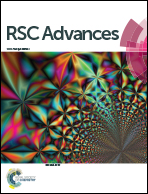Response surface methodology as an efficient tool for optimizing the Fischer–Tropsch process over a novel Fe–Mn nano catalyst†
Abstract
A novel Fe–Mn–resol/SiO2 nano-catalyst with improved surface area and porosity was prepared using a co-precipitation method. Characterization of both the precursor and calcined catalysts was carried out using X-ray diffraction, scanning electron microscopy, energy dispersive X-ray analysis, temperature-programmed reduction, N2 adsorption–desorption, Fourier transform infrared spectroscopy and laser particle size analysis. The optimization of the process parameters for Fischer–Tropsch synthesis over the Fe–Mn–resol/SiO2 catalyst was developed using response surface methodology coupled with central composite design. The relationship between the responses, i.e., CO conversion, light hydrocarbons, heavy hydrocarbons and alcohols fragments, with four independent variables, i.e., pressure, H2/CO molar ratio, gas hourly space velocity and temperature, was presented in the form of empirical mathematical models. Analysis of variance was used for an investigation into the validity and predictability of the Fischer–Tropsch synthesis. Experimental runs under optimal conditions were repeated and compared with the simulated values obtained from the model. There was good agreement between the experimental and simulated values.


 Please wait while we load your content...
Please wait while we load your content...